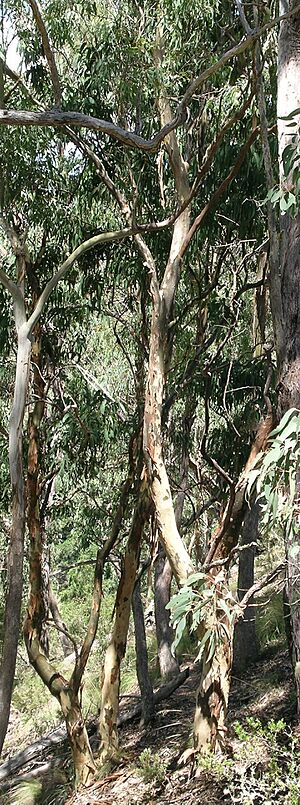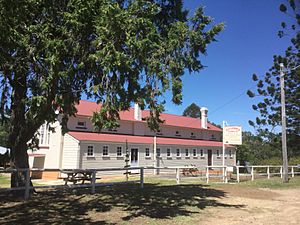Hillgrove, New South Wales facts for kids
Quick facts for kids HillgroveNew South Wales |
|
|---|---|

Hillgrove welcome sign in 2008
|
|
| Established | 1884 |
| Postcode(s) | 2350 |
| Elevation | 1,000 m (3,281 ft) |
| Location |
|
| LGA(s) | Armidale Regional Council |
| State electorate(s) | Northern Tablelands |
| Federal Division(s) | New England |
Hillgrove is a small, historic village in the Northern Tablelands region of New South Wales, Australia. It used to be a busy gold mining town. Today, only about 95 people live there.
The village is located about 30 kilometers (18 miles) east of Armidale. It sits high up on a granite plateau, about 1,000 meters (3,280 feet) above sea level. It's also very close to the beautiful Oxley Wild Rivers National Park.
Hillgrove was once one of the most important places for finding gold in New South Wales. Over 15,000 kilograms (33,000 pounds) of gold were found here. It also produced a lot of other valuable minerals like antimony and tungsten.
Contents
Hillgrove's Past: A Mining Story

Early Days and Gold Rush
The town was first called Eleanora Township. This name came from an antimony mine that was the only reason the town existed for almost ten years after 1876. The name Hillgrove was given to the town in 1888.
Some gold was found in the Bakers Creek gorge as early as 1857. But serious mining didn't start until antimony was discovered in the late 1870s. Miners dug a main shaft in Bakers Creek that went 610 meters (2,000 feet) deep! Special tramways, powered by a steam engine, pulled carts up and down the steep slopes to the mines.
The town of Hillgrove officially started in 1884. It grew very quickly in the 1880s and 1890s as more and more mining companies opened. The Hillgrove Post Office opened in 1884. Another post office, called Hillgrove West, opened in 1890 and later changed its name to Metz.
Hillgrove's Golden Age
Around 1898, Hillgrove was at its busiest. Nearly 3,000 people lived there, which was almost as many as in Armidale! The town had many important buildings and services:
- Four churches
- Six hotels
- Two schools
- A school of arts (a place for learning and culture)
- A hospital
- Several banks
- A stock exchange (where shares in companies were bought and sold)
- A court house and police station
- A recreation ground
- A technical college
Hillgrove even had its own local newspaper, the Hillgrove Guardian. In 1895, it became the first town in Australia to get electricity from hydroelectricity. This power came from Gara Gorge, west of the town.
Decline and New Discoveries
After 1900, Hillgrove started to shrink. It became too difficult and expensive to dig deeper into the mines. Investors and miners looked for easier places to find gold. By the 1920s, the gold was mostly gone, and antimony prices dropped. This caused mining companies to close down.
In total, the Eleanora and Bakers Creek Mines produced 15,600 kilograms (34,392 pounds) of gold. Many of the town's buildings were taken apart and moved to Armidale and other towns. By 1933, only 241 people were left in Hillgrove.
Gold mining started again for a short time between 1937 and 1940. A small mine called the "Damned If I Know Mine" found a lot of tungsten ore. This mine made a big profit, especially during World War II. Tungsten was very important because it made steel stronger, which was needed for the war. Antimony mining also became popular again in 1969, helping the village to keep going.
Hillgrove in the 2000s
In 2004, a company called Straits Resources bought the Hillgrove Gold Project. They planned to develop the area further. However, the mine closed for several months in 2009 because global prices for minerals changed a lot.
Later, a company from Hong Kong owned the mine. But in December 2015, it closed again. This was mainly because the price of antimony fell sharply.
Preserving Hillgrove's History
Today, only a few big buildings remain in Hillgrove, like the old post office and the school. The school buildings, built in 1897, are now home to the Hillgrove Rural Life and Industry Museum. This museum helps people learn about the town's mining past and rural life.
The Hillgrove Goldmining Area and the Antimony Mine on Stockton Road are very important. They have been added to the Register of the National Estate, which means they are protected for their historical value.
Places to Visit in Hillgrove
Hillgrove and the surrounding area offer some interesting places to explore.
- Long Point Campground: This campground is about 18 kilometers (11 miles) south of Hillgrove. It's in the wild Oxley Wild Rivers National Park. You can find walking tracks here that go through dry rainforest and around the edge of the gorge. These tracks offer great views of the Chandler and Macleay River systems. You might also see some rare Eucalyptus michaeliana trees, also known as Hillgrove Gums. These trees have unique green, mottled trunks with bark that peels off like puzzle pieces.
- Bakers Creek Falls Lookout: This lookout is about 1.5 kilometers (1 mile) from the Waterfall Way. It gives you amazing views of where the Bakers Creek Gorge begins.
- Metz Gorge Viewing Platform: Metz, once called West Hillgrove, is on the other side of the Bakers Creek gorge from Hillgrove. It has a viewing platform at Metz Gorge. From here, you can see some old parts of the Bakers Creek Mine at the bottom of the gorge, which is 490 meters (1,600 feet) below Hillgrove. The mine shaft went even deeper, almost to sea level!




